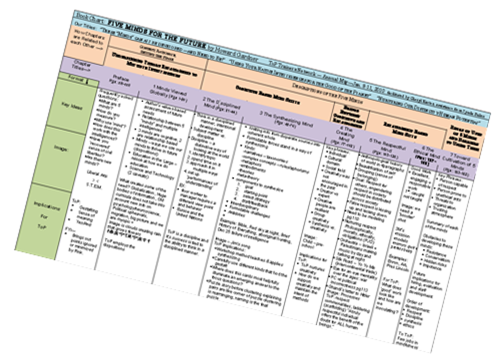- Home
- Membership
- Training & Certification
- Annual Gathering & Events
- Initiatives/Action Teams
- Resource Library
ToP® Book Charting"Charting is a means of integrating active visual and kinesthetic capacities with the more passive auditory process of reading language. By creating a rational and visual graphic of the whole of the written material being studied, the learner activates more of the brain in the inquiry process and amplifies the efficiency and effectiveness of learning." --George Packard
Note: This page is an effort to organize materials to make it easier for members to find them. It is a work in progress. Please share your reactions and suggestions on the ToP Community Forum under ToP Cares forum (scroll down to 2013 Action Teams). The charts we have are listed. If you have copies of the older book charts (those unlisted here), please send them to Nileen Verbeten or Ester Mae Cox so we can add them.
What is Book charting?(Note: The Technology of Participation (ToP®) methods were developed since the early 60’s by the Institute of Cultural Affairs (ICA), often by global teams sharing and refining their processes. This summary is provided by Cheryl Kartes, CTF, MN ToP Mentor Trainer. This method is taught in the Power of Image Shift course.) Book Charting is a facilitated group study process that uses everyone’s input and insights to develop an “image” of the whole book. Developed by the ICA for in-depth study of books, these instructions provide a fast way to access the key ideas in a book, adapted initially by Dr. K. Elise Packard, from ICA’s more in-depth practice. Participants are assigned a chapter/section to read and prepare a summary on a one-third or one-half vertical strip of poster paper using the Chapter Summary Instructions below. Participants then meet in a plenary session to report out chapter summaries and exchange their perspectives and opinions on the assigned reading. Facilitated group discussions reflect on the themes within the book — drawing parallels from personal experience or other information sources — and reflect on the implications, or how to incorporate concepts/practices into their own work or organization. The process provides a dynamic and creative approach to internalizing information and is fun. The number of participants required is typically a function of the number of chapters within a book. If there are not enough participants for all of the chapters at a session, individuals will be assigned more than one chapter to summarize. The Power of Image Shift Workbook lists many benefits of charting. Some of them are:
Book charting is a tradition of ToP Network annual meetings. View Charting Instructions and Sample DocumentsFour Level Charting Process – Jo Nelson, ICA-Canada - 2011 pdf Sample Book Chart format – ICA- Canada pdf Charting Session Example and Worksheet – Larry Philbrook – ICA-Taiwan pdf / powerpoint
View Book Charts2014 - MinneapolisSpeak Peace in a World of Conflict: What You Say Next Will Change Your World, by Marshall B. Rosenberg, Ph.D. chart
2013 – Durham:Made to Stick: Why Some Ideas Survive and Others Die, 2007, Chip Heath (Author), Dan Heath (Author) pdf Facilitating with Heart: Awakening Personal Transformation and Social Change, 2010, Martha Lasley (Author), Charting Leader, Cheryl Kartes Leadership Mastery: How to Challenge Yourself and Others to Greatness, 2009, Dale Carnegie Training (Author)
2012 – Sacramento:Walk Out Walk On: A Learning Journey into Communities Daring to Live the Future, 2011, Margaret Weatley and Deborah Frieze pdf Also offered is a companion article entitled "Creativity Without Control" pdf Bending History: Vol II Societal Reformulation-toward a New Social Vehicle, 2011, John L Epps (Editor), M George Walters (Afterword), James Campbell (Foreword), Charting Leader: Cheryl Kartes pdf The New Universe and the Human Future: How a Shared Cosmology Could Transform the World (The Terry Lectures Series), Nancy Ellen Abrams (Author), Joel R. Primack (Author), Charting Leaders: Sheila Cooke and Christopher Cooke pdf 2011 – San AntonioRiding the Waves of Culture: Understanding Diversity in Global Business: Alfons Trompenaars, (Author), Charles Hampden-Turner (Author) pdf Blessed Unrest: How the Largest Movement in the World Came into Being and Why No One Saw It Coming, Paul Hawken (Author) pdf / Word Process Design, A Practical Guide to What to do When and How for Facilitators, Consultants, Managers and Coaches: Making it Work, Dorothy Strachan (Author) pdf
2010 -- MinneapolisFive Minds for the Future, Howard Gardner (Author) pdf
OlderPresence: Human Purpose and the Field of the Future, Peter M. Senge (Author), C. Otto Scharmer (Author), Joseph Jaworski (Author), Betty Sue Flowers (Author), Facilitated by The Pathstones Group pdf / Word
|

